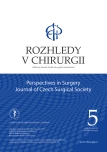-
Medical journals
- Career
Early complications in surgery of umbilical and epigastric hernias
Authors: P. Sedláček 1; T. Fürst 2; Z. Sedláčková 3
Authors‘ workplace: Chirurgické oddělení Vojenské nemocnice Olomouc 1; Katedra matematické analýzy a aplikací matematiky, Přírodovědecká fakulta Univerzity Palackého 2; Radiologická klinika Fakultní nemocnice a Lékařské fakulty Univerzity Palackého Olomouc 3
Published in: Rozhl. Chir., 2020, roč. 99, č. 5, s. 207-211.
Category: Original articles
doi: https://doi.org/10.33699/PIS.2020.99.5.207–211Overview
Introduction: Repairs of umbilical and epigastric hernias are common surgical procedures; the choice of the surgical method generally depends on the size of the hernial sac and fascial defect.
Methods: Data of patients operated on for umbilical or epigastric hernias in our hospital during two years were assessed retrospectively. The study group included 264 patients; 212 had an umbilical hernia and 52 had an epigastric hernia. We assessed epidemiologic and clinical parameters and their correlation with the occurrence of early postoperative complications. We also looked for the recurrence rate, although during only a short follow-up period.
Results: In the case of umbilical hernias, early complications occurred in 6.7% (11/165) after surgery with a simple suture and in 4.3% (2/47) with mesh repair, and the recurrence rates were 3% (5/165) and 21.3% (10/47), respectively. The risk of early complications was significantly higher in larger hernias. The recurrence rate increased with older age, an increased size of the hernial sac and fascial defect, and in patients with type 2 diabetes. In epigastric hernias, early complications occurred in 5.3% (1/19) after surgery with a simple suture and in 6.1% (2/33) with mesh repair. Recurrences only occurred in operations with mesh repair, in 9% (3/33). The risk of early complications was significantly higher in type 2 diabetes patients.
Conclusion: Early complications were slightly more frequent in epigastric hernia repairs with mesh implantation, but this was not the case of umbilical hernias. We recommend mesh implantation in larger and borderline sized hernias to reduce the risk of recurrence.
Keywords:
recurrence – postoperative complication – umbilical hernia
Sources
- Pazdírek F. Břišní stěna a kýly. In: Hoch J, Leffler J. Speciální chirurgie. 3. vydání. Praha, Maxdorf Jessenius 2011 : 83–89.
- Hazey JW. Hernia. In: Ellison ECh, Zollinger RM. Zollinger´s atlas of surgical operations. 10th ed. McGraw-Hill Education 2016 : 400–6.
- Malik AM, Jawaid A, Talpur AH, et al. Mesh versus non-mesh repair of ventral abdominal hernias. J Ayub Med Coll Abbottabad. 2008;20(3):54–56.
- Dalenbäck J, Andersson C, Ribokas D, et al. Long-term follow-up after elective adult umbilical hernia repair: low recurrence rates also after non-mesh repairs. Hernia 2013;17(4):493–497. doi:10.1007/s10029-012-0988-0.
- Stabilini C, Stella M, Frascio M, et al. Mesh versus direct suture for the repair of umbilical and epigastric hernias. Ten-year experience. Ann Ital Chir. 2009;80(3):183–187.
- Berger RL, Li LT, Hicks SC, et al. Suture versus preperitoneal polypropylene mesh for elective umbilical hernia repairs. J Surg Res. 2014;192(2):426–31. doi:10.1016/j.jss.2014.05.080.
- Groene SA, Heniford DW, Prasad T, et al. Identifying effectors of outcomes in patients with large umbilical hernias. Am Surg. 2016;82(7):613–621.
- Venclauskas L, Jokubauskas M, Zilinskas J, et al. Long-term follow-up results of umbilical hernia repair. Wideochir Inne Tech Maloinwazyjne 2017;12(4):350–356. doi:10.5114/wiitm.2017.70327.
- Malý O, Sotona O. Long-term follow-up results after open small umbilical hernia repairs. Rozhl Chir. 2014;93(4):208–211.
- Winsnes A, Haapamäki MM, Gunnarsson U, et al. Surgical outcome of mesh and suture repair in primary umbilical hernia: postoperative complications and recurrence. Hernia 2016;20(4):509–516. doi:10.1007/s10029-016-1466-x.
- Kaufmann R, Halm JA, Eker HH, et al. Mesh versus suture repair of umbilical hernia in adults: a randomised, double-blind, controlled, multicentre trial. Lancet 2018;3;391(10123):860–869. doi:10.1016/S0140-6736(18)30298-8.
- Heise JW, Ewodo Beyeme JM, Tomczak J, et al. Double running suture line repair in primary umbilical hernias − analysis after 282 cases. Zentralbl Chir. 2019;144(1):44–9. doi: 10.1055/a-0788-9533.
- Schumacher OP, Peiper C, Lörken M, et al. Long-term results after Spitzy´s umbilical hernia repair. Der Chirurg 2003;74 : 50–4. [In German]. doi:10.1007/s00104-002-0536-z.
- Köhler G, Luketina RR, Emmanuel K. Sutured repair of primary small umbilical and epigastric hernias: concomitant rectus diastasis is a significant risk factor for recurrence. Word J Surg. 2015;39(1):121–126. doi:10.1007/s00268-014-2765-y.
- Burger JW, Luijendijk RW, Wim C, et al. Long-term follow-up of a randomised controlled trial of suture versus mesh repair of incisional hernia. Annals of Surgery 2004;240 : 578–585. doi:10.1097/01.sla.0000141193.08524.e7.
- Polat C, Dervisoglu A, Senyurek G, et al. Umbilical hernia repair with the prolene hernia system. AM J Surg. 2005;190 : 61–64. doi:10.1016/j.amjsurg.2004.09.021.
- Helgstrand F, Rosenberg J, Kehlet H, et al. Outcomes after emergency versus elective ventral hernia repair: a prospective nationwide study. World J Surg. 2013;37 : 2273–2279. doi:10.1007/s00268-013-2123-5.
- Bencini L, Sanchez LJ, Bernini M, et al. Predictors of recurrence after laparoscopic ventral hernia repair. Surg Laparosc Endosc Percutan Tech. 2009;19 : 128–132. doi:10.1097/SLE.0b013e31819cb04b.
Labels
Surgery Orthopaedics Trauma surgery
Article was published inPerspectives in Surgery

2020 Issue 5-
All articles in this issue
- Management of oesophageal anastomosis dehiscence after oesophagectomy for oesophageal cancer
- Early complications in surgery of umbilical and epigastric hernias
- Surgical treatment of cervical spine fractures in ankylosing spondylitis patients: posterior stabilization using intraoperative CT scanner-based navigation
- Upper urinary tract urothelial carcinomas – our experience
- “Maximal” minimally invasive thymectomy in patients with Nonthymomatous Myasthenia Gravis – short-term results over a 10year period – retrospective study
- Abdominal abscess associated with salmonellosis − case report
- Aorto-caval fistula – case report
- Covidí příležitost
- Perspectives in Surgery
- Journal archive
- Current issue
- Online only
- About the journal
Most read in this issue- Early complications in surgery of umbilical and epigastric hernias
- Upper urinary tract urothelial carcinomas – our experience
- Management of oesophageal anastomosis dehiscence after oesophagectomy for oesophageal cancer
- Abdominal abscess associated with salmonellosis − case report
Login#ADS_BOTTOM_SCRIPTS#Forgotten passwordEnter the email address that you registered with. We will send you instructions on how to set a new password.
- Career

